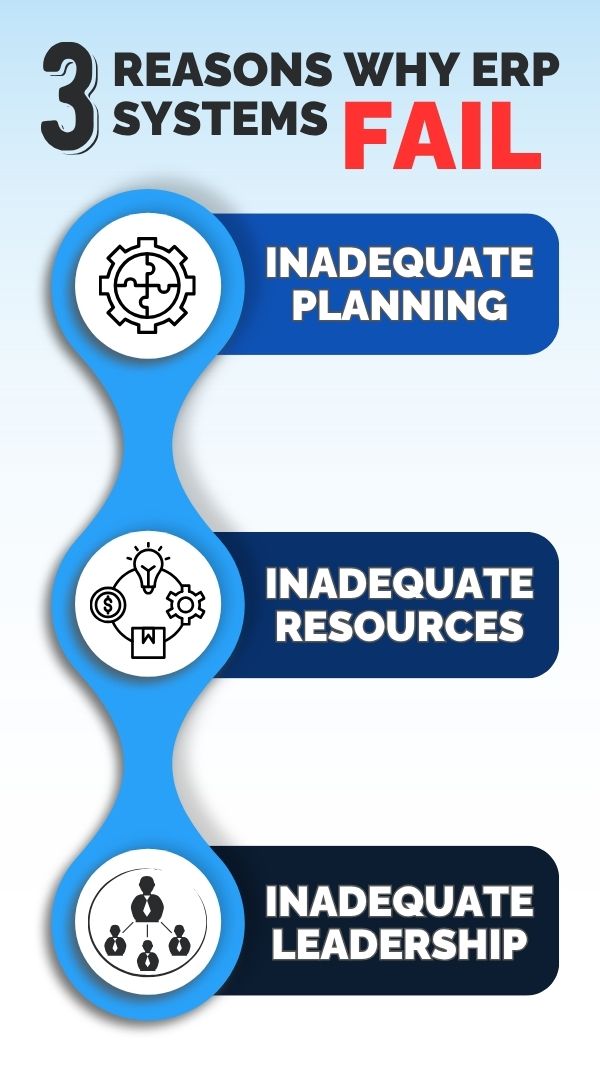Part 1 of Our ERP Transformation Series
Over the past three decades, we’ve seen countless organizations embark on ERP transformations—some achieving remarkable success, many struggling, and far too many failing to realize their intended value. Whether it’s SAP, Oracle, or another Tier 1 ERP platform, the story tends to follow a familiar pattern: the technology evolves, the buzzwords change, but the root causes of failure remain strikingly consistent.
In this first installment of our ERP Transformation Series, we’ll focus on three recurring issues that have plagued ERP programs since the mid-’90s—issues that we continue to see today, often perpetuated by the very Tier 1 implementation partners trusted to lead these transformations.

1. Inadequate Planning: The Foundation That Never Set Right
For years, we’ve watched projects rush through the early stages of planning to “accelerate” delivery, often under pressure from aggressive timelines or fixed-bid contracts. Unfortunately, this shortcut rarely pays off.
Instead of a thorough planning phase that aligns business strategy, project scope, company background, and other reality-driven setups with expected outcomes, many programs default to cookie-cutter approach planning with inadequate planning details and unrealistic assumptions. The result? Misaligned expectations, under-scoped requirements, and a foundation built on assumptions rather than facts.
True planning demands more than a few weeks of discovery. It requires time to define the business case, challenge outdated processes, and align executive vision. ERP is not an IT upgrade—it’s a business transformation (see ERP Implementation Best Practices). When this distinction gets lost, failure becomes almost inevitable.
2. Inadequate Resources: The Right People, in the Wrong Roles (or Not There at All)
Leading system integrator’s proposal often promises “top talent” and “industry best practices.” Yet once the project begins, those experts frequently vanish, replaced by junior consultants or offshore teams learning on the job.
This “bait and switch” approach has been a systemic issue for decades. The consequences are predictable: slow decision-making, inconsistent design quality, and endless rework. Meanwhile, client-side teams—often already stretched thin—are expected to shoulder the burden, juggling day jobs with transformation duties.
ERP programs succeed when both the client and partner invest in the right people—experienced practitioners who understand not just the software, but the business context. When resources are treated as interchangeable line items, quality suffers, and so does the outcome.
3. Inadequate Leadership Experience: When Governance Turns into Guesswork
ERP transformations require leadership with scars earned from prior programs—leaders who understand what it takes to steer through complexity, resistance, and change fatigue. Unfortunately, too many ERP initiatives are led by executives with limited exposure to transformation dynamics, or by PMOs lacking real authority, or – literally – the white hair type of guys who have the decades of experience and right leadership-foresight to read the program tea leaves.
Compounding this, Tier 1 partners often install governance frameworks that look impressive on paper, but fall short in practice—favoring status reporting over decision-making, and compliance over accountability. The absence of experienced leadership manifests as unclear priorities, shifting scope, and a reactive rather than strategic approach to delivery.
Strong ERP leadership isn’t about managing timelines—it’s about orchestrating alignment, driving clarity, seeing what others can’t, and ensuring the program stays tied to measurable business value.
In Summary
After 30 years in this space, we can confidently say that technology is rarely the reason ERP programs fail. The systems—SAP, Oracle, or otherwise—are capable. The real problem lies in execution, often underpinned by inadequate planning, under-resourced teams, and inexperienced leadership.
In the next installment of this series, we’ll explore how organizations can course-correct—how to design ERP transformations with the right structure, governance, and partner accountability to set a foundation for success.
If your organization is planning or currently navigating an ERP transformation, it’s worth asking: Are we truly ready? Or are we simply hoping the system will fix what strategy hasn’t?
About Gravity IT Resources
Gravity is a Human Capital Management company headquartered in Fort Lauderdale with offices across the country including Atlanta, Charlotte, Columbus, Cincinnati, Nashville, DC, Salt Lake City, San Diego and Tampa. Our company has been recognized by Inc. Magazine as an “Inc. 5000” award winner and one of the fastest growing privately held companies in the United States for the last 7 consecutive years (2019, 2020, 2021, 2022, 2023, 2024, 2025). Additionally, Gravity is proud to be Great Place to Work certified for the 5th year in a row (2021, 2022, 2023, 2024, 2025) and was also recognized on the SIA’s Fastest-Growing Staffing Firms in the US list the last two years (2024, 2025).
Gravity helps prominent clients like Salesforce, Chewy, Carnival Cruise Lines, AutoNation, Mosaic and hundreds of other enterprise and SMB companies to identify, recruit and hire IT professionals for their most critical projects and jobs. Our recruitment spans across various roles, including artificial intelligence (AI) specialists, software engineers, cloud engineers, project managers, data engineers, business analysts, security engineers, CXO leaders and more.
Gravity provides a variety of delivery models and services designed to meet client needs efficiently and effectively.
- Contract, Contract-to-Hire & Direct Hire of US-based Resources
- Nearshore Staff Augmentation
- Managed Team Services
- Executive Search
- ERP Program Leadership
- Workday Certified Staffing Partner
To learn more about Gravity IT Resources practices, career opportunities and culture, visit gravityitresources.com



